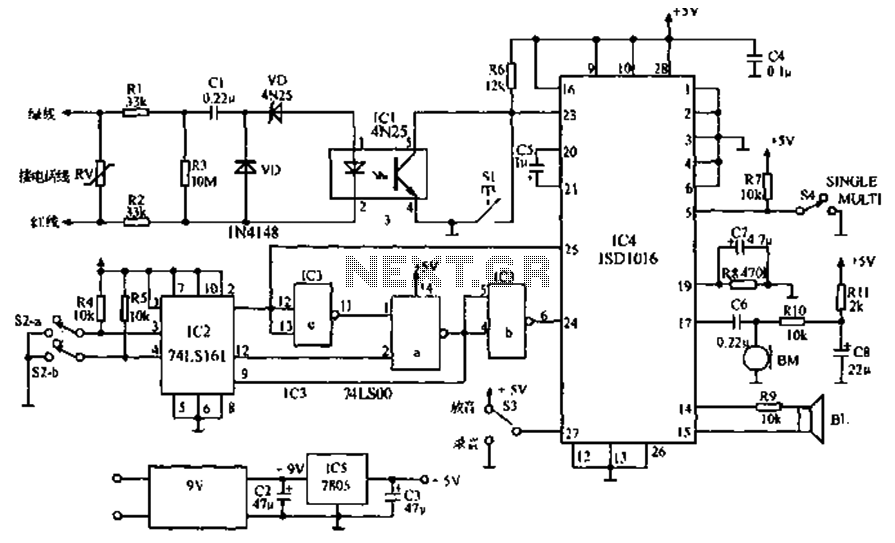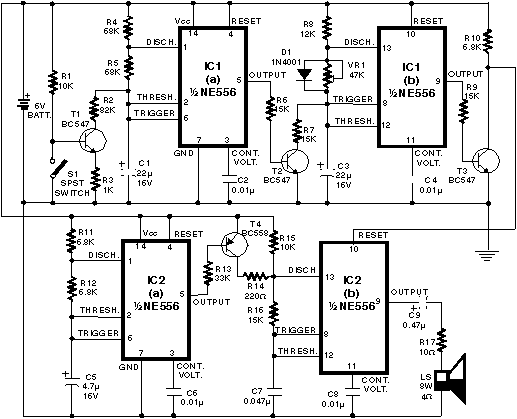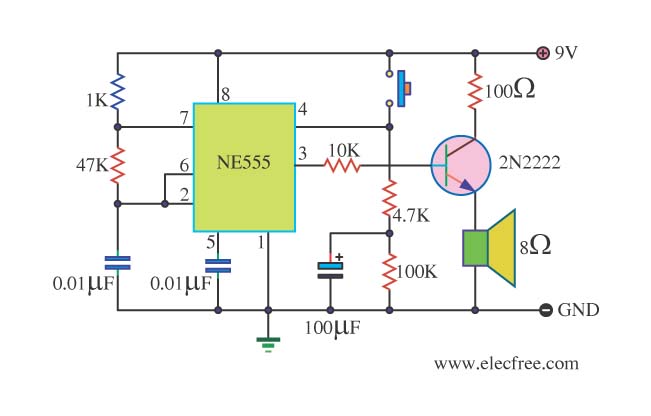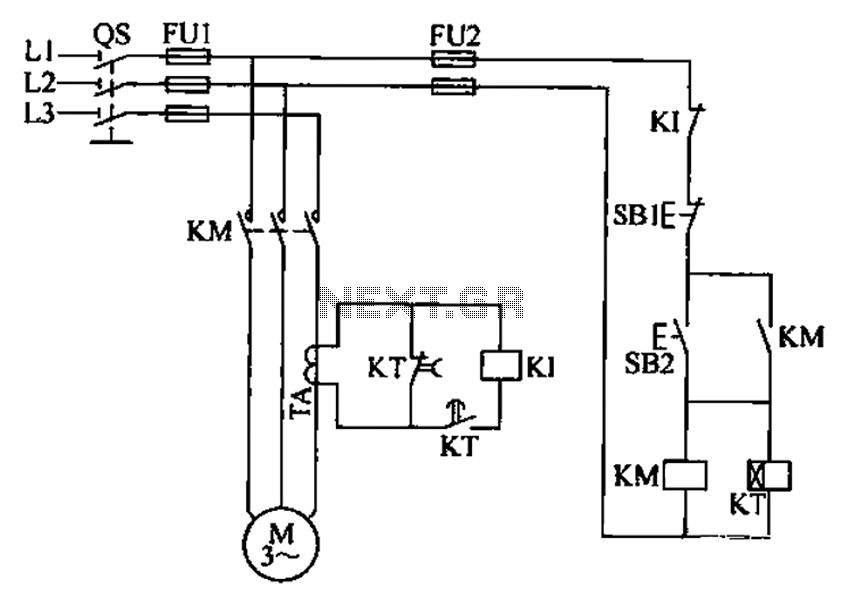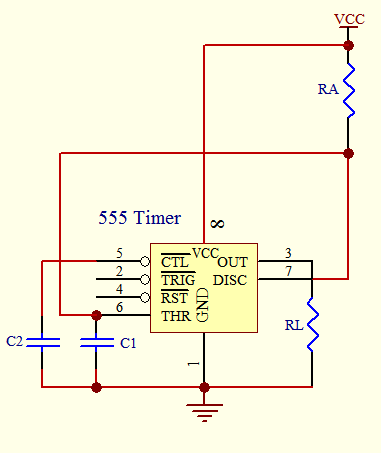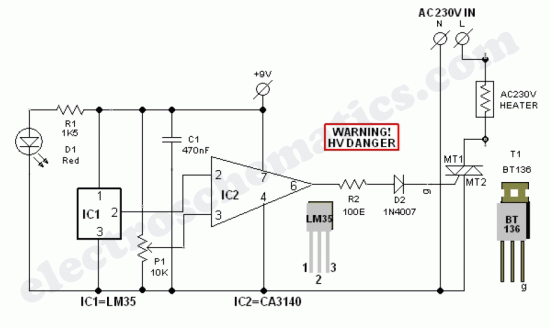
DC motor speed controller with 555 timer
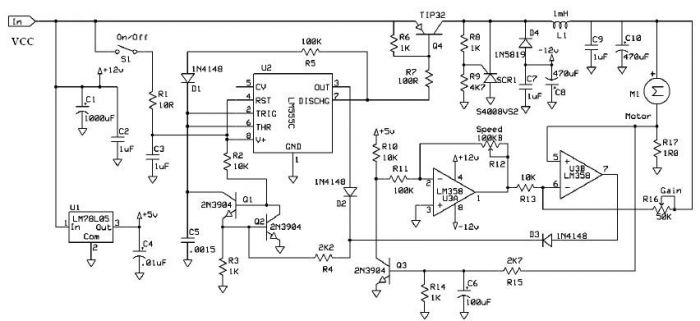
Speed regulation is achieved by monitoring the motor current with resistor R17 and utilizing it as positive feedback to offset motor resistance losses. The gain potentiometer should be adjusted to just below the threshold where motor speed begins to oscillate. Once this threshold is identified, it may be necessary to modify the value of resistor R11 to enhance the speed control range. Transistor Q3 serves to limit the motor current. Diode D4 and capacitor C8 capture some of the inductive kick from inductor L1, generating a loosely regulated -12 volts for operational amplifier U3. Silicon-controlled rectifier SCR1 functions as a standard flyback diode after capacitor C8 has stored the required energy, thereby preventing significant power losses.
In this circuit design, speed regulation is a critical function that relies on precise feedback mechanisms to maintain optimal motor performance. The use of resistor R17 allows for effective measurement of the motor current, which is essential in compensating for any losses due to motor resistance. The gain potentiometer plays a vital role in fine-tuning the feedback loop; setting it just below the oscillation threshold ensures stable operation without introducing instability into the system.
Adjusting resistor R11 is crucial for expanding the range of speed control. This resistor can influence the feedback gain, allowing for a broader spectrum of motor speeds to be achieved while maintaining control fidelity. The careful selection of R11 can lead to improved responsiveness and stability in the motor's operation.
Transistor Q3 functions as a current limiter, protecting the circuit from excessive current that could damage components or lead to inefficient operation. This current limiting feature is essential for safeguarding the integrity of the system, especially during transient conditions or load variations.
The interaction between diode D4 and capacitor C8 is instrumental in managing the inductive kick generated by inductor L1. This inductive kick can lead to voltage spikes that may adversely affect other components in the circuit. By capturing this energy, C8 provides a stable -12 volts to operational amplifier U3, ensuring it operates within its specified voltage range. This regulation is crucial for the consistent performance of the operational amplifier, which may be involved in further signal processing or control tasks.
Finally, the role of silicon-controlled rectifier SCR1 as a flyback diode is significant in managing energy recovery in the circuit. Once C8 has absorbed the necessary energy, SCR1 prevents energy from dissipating as heat, thus enhancing overall system efficiency. This design consideration minimizes power losses and ensures that the circuit operates effectively under various load conditions.Speed regulation is accomplished by sensing the motor current with R17 and using it as positive feedback to compensate for motor resistance loss. The gain pot should be set to a point just below the point where the motor speed oscillates. After finding this point, you may want to change the value of R11 to get better speed control range. Q3 limits motor current. D4 and C8 capture some of L1`s inductive kick to produce a loosely regulated -12 volts for U3. SCR1 acts like the usual flyback diode once C8 has stored the needed energy, preventing significant power losses. 🔗 External reference
In this circuit design, speed regulation is a critical function that relies on precise feedback mechanisms to maintain optimal motor performance. The use of resistor R17 allows for effective measurement of the motor current, which is essential in compensating for any losses due to motor resistance. The gain potentiometer plays a vital role in fine-tuning the feedback loop; setting it just below the oscillation threshold ensures stable operation without introducing instability into the system.
Adjusting resistor R11 is crucial for expanding the range of speed control. This resistor can influence the feedback gain, allowing for a broader spectrum of motor speeds to be achieved while maintaining control fidelity. The careful selection of R11 can lead to improved responsiveness and stability in the motor's operation.
Transistor Q3 functions as a current limiter, protecting the circuit from excessive current that could damage components or lead to inefficient operation. This current limiting feature is essential for safeguarding the integrity of the system, especially during transient conditions or load variations.
The interaction between diode D4 and capacitor C8 is instrumental in managing the inductive kick generated by inductor L1. This inductive kick can lead to voltage spikes that may adversely affect other components in the circuit. By capturing this energy, C8 provides a stable -12 volts to operational amplifier U3, ensuring it operates within its specified voltage range. This regulation is crucial for the consistent performance of the operational amplifier, which may be involved in further signal processing or control tasks.
Finally, the role of silicon-controlled rectifier SCR1 as a flyback diode is significant in managing energy recovery in the circuit. Once C8 has absorbed the necessary energy, SCR1 prevents energy from dissipating as heat, thus enhancing overall system efficiency. This design consideration minimizes power losses and ensures that the circuit operates effectively under various load conditions.Speed regulation is accomplished by sensing the motor current with R17 and using it as positive feedback to compensate for motor resistance loss. The gain pot should be set to a point just below the point where the motor speed oscillates. After finding this point, you may want to change the value of R11 to get better speed control range. Q3 limits motor current. D4 and C8 capture some of L1`s inductive kick to produce a loosely regulated -12 volts for U3. SCR1 acts like the usual flyback diode once C8 has stored the needed energy, preventing significant power losses. 🔗 External reference
